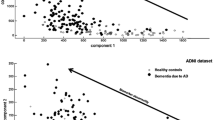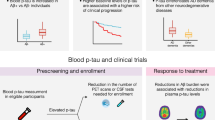Abstract
In light of the dramatically increasing prevalence of Alzheimer’s disease (AD) to be expected in the future, the development of novel therapeutics, improved differential and early diagnostics, and means for the identification of individuals at risk are urgently needed. At present, instruments for a reliable differential diagnosis in clinical dementia, mild cognitive impairment, or prodromal stages have direct practical implications for differentiating secondary dementias from neurodegenerative conditions and for treatment decisions. It may also be reasonable to enforce the incorporation of biomarkers into clinical studies as surrogate outcome parameters and as an attempt to optimize recruitment criteria. Recently, revised research criteria increasingly rely on the interpretation of biomarker patterns, including neuroimaging and CSF-based neurochemical dementia diagnosis (NDD) in supporting the clinical diagnosis. Here, we review the performance of current core CSF biomarkers (Aβ42 peptide, total tau protein and phosphorylated tau species) and try to define objectives for prospective markers, also considering blood-based tests, which would increase the acceptance and wide application of NDD. Moreover, we evaluate the role and the limitations of genotyping in the predictive diagnosis of AD.
Similar content being viewed by others
References
Albert MS, DeKosky ST et al (2011) The diagnosis of mild cognitive impairment due to Alzheimer’s disease: recommendations from the National Institute on Aging-Alzheimer’s Association workgroups on diagnostic guidelines for Alzheimer’s disease. Alzheimers Dement 7(3):270–279
Alexander GE, Chen K et al (2002) Longitudinal PET evaluation of cerebral metabolic decline in dementia: a potential outcome measure in Alzheimer’s disease treatment studies. Am J Psychiatr 159(5):738–745
Anchisi D, Borroni B et al (2005) Heterogeneity of brain glucose metabolism in mild cognitive impairment and clinical progression to Alzheimer disease. Arch Neurol 62(11):1728–1733
Andreasson U, Portelius E et al (2007) Aspects of beta-amyloid as a biomarker for Alzheimer’s disease. Biomarkers Med 1(1):59–78
Arai H, Ishiguro K et al (2000) CSF phosphorylated tau protein and mild cognitive impairment: a prospective study. Exp Neurol 166(1):201–203
Blennow K, Hampel H (2003) CSF markers for incipient Alzheimer’s disease. Lancet Neurol 2(10):605–613
Blennow K, Vanmechelen E et al (2001) CSF total tau, Abeta42 and phosphorylated tau protein as biomarkers for Alzheimer’s disease. Mol Neurobiol 24(1–3):87–97
Buee L, Bussiere T et al (2000) Tau protein isoforms, phosphorylation and role in neurodegenerative disorders. Brain Res Brain Res Rev 33(1):95–130
Buerger K, Ewers M et al (2006) CSF phosphorylated tau protein correlates with neocortical neurofibrillary pathology in Alzheimer’s disease. Brain J Neurol 129(Pt 11):3035–3041
Buerger K, Teipel SJ et al (2002) CSF tau protein phosphorylated at threonine 231 correlates with cognitive decline in MCI subjects. Neurology 59(4):627–629
Chetelat G, Desgranges B et al (2003) Mild cognitive impairment: can FDG-PET predict who is to rapidly convert to Alzheimer’s disease? Neurology 60(8):1374–1377
Clarfield AM (2003) The decreasing prevalence of reversible dementias: an updated meta-analysis. Arch Intern Med 163(18):2219–2229
Fagan AM, Mintun MA et al (2006) Inverse relation between in vivo amyloid imaging load and cerebrospinal fluid Abeta42 in humans. Ann Neurol 59(3):512–519
Fagan AM, Mintun MA et al (2009) Cerebrospinal fluid tau and ptau(181) increase with cortical amyloid deposition in cognitively normal individuals: implications for future clinical trials of Alzheimer’s disease. EMBO Mol Med 1(8–9):371–380
Farrer LA, Cupples LA et al (1997) Effects of age, sex, and ethnicity on the association between apolipoprotein E genotype and Alzheimer disease. A meta-analysis. APOE and Alzheimer Disease Meta Analysis Consortium. JAMA 278(16):1349–1356
Ferri CP, Prince M et al (2005) Global prevalence of dementia: a Delphi consensus study. Lancet 366(9503):2112–2117
Frankfort SV, Tulner LR et al (2008) Amyloid beta protein and tau in cerebrospinal fluid and plasma as biomarkers for dementia: a review of recent literature. Curr Clin Pharmacol 3(2):123–131
Hampel H, Broich K et al (2009) Biological markers for early detection and pharmacological treatment of Alzheimer’s disease. Dialogues Clin Neurosci 11(2):141–157
Hampel H, Buerger K et al (2004) Measurement of phosphorylated tau epitopes in the differential diagnosis of Alzheimer disease: a comparative cerebrospinal fluid study. Arch Gen Psychiatr 61(1):95–102
Hampel H, Burger K et al (2008) Core candidate neurochemical and imaging biomarkers of Alzheimer’s disease. Alzheimers Dement 4(1):38–48
Hampel H, Frank R et al (2010) Biomarkers for Alzheimer’s disease: academic, industry and regulatory perspectives. Nat Rev Drug Discov 9(7):560–574
Hampel H, Wilcock G et al (2011) Biomarkers for Alzheimer’s disease therapeutic trials. Prog Neurobiol 95(4):579–593
Hansson O, Zetterberg H et al (2006) Association between CSF biomarkers and incipient Alzheimer’s disease in patients with mild cognitive impairment: a follow-up study. Lancet Neurol 5(3):228–234
Hardy J, Selkoe DJ (2002) The amyloid hypothesis of Alzheimer’s disease: progress and problems on the road to therapeutics. Science 297(5580):353–356
Harold D, Abraham R et al (2009) Genome-wide association study identifies variants at CLU and PICALM associated with Alzheimer’s disease. Nat Genet 41(10):1088–1093
Haroutunian V, Schnaider-Beeri M et al (2008) Role of the neuropathology of Alzheimer disease in dementia in the oldest-old. Arch Neurol 65(9):1211–1217
Hollingworth P, Harold D et al (2011) Common variants at ABCA7, MS4A6A/MS4A4E, EPHA1, CD33 and CD2AP are associated with Alzheimer’s disease. Nat Genet 43(5):429–435
Hu YY, He SS et al (2002) Elevated levels of phosphorylated neurofilament proteins in cerebrospinal fluid of Alzheimer disease patients. Neurosci Lett 320(3):156–160
Jack CR Jr, Albert MS et al (2011) Introduction to the recommendations from the National Institute on Aging-Alzheimer’s Association workgroups on diagnostic guidelines for Alzheimer’s disease. Alzheimers Dement 7(3):257–262
Jonsson T, Atwal JK et al (2012) A mutation in APP protects against Alzheimer’s disease and age-related cognitive decline. Nature 488(7409):96–99
Kim J, Basak JM et al (2009) The role of apolipoprotein E in Alzheimer’s disease. Neuron 63(3):287–303
Klunk WE, Engler H et al (2004) Imaging brain amyloid in Alzheimer’s disease with Pittsburgh Compound-B. Ann Neurol 55(3):306–319
Kornhuber J, Schmidtke K et al (2009) Early and differential diagnosis of dementia and mild cognitive impairment: design and cohort baseline characteristics of the German Dementia Competence Network. Dement Geriatr Cogn Disord 27(5):404–417
Lambert JC, Heath S et al (2009) Genome-wide association study identifies variants at CLU and CR1 associated with Alzheimer’s disease. Nat Genet 41(10):1094–1099
Li G, Sokal I et al (2007) CSF tau/Abeta42 ratio for increased risk of mild cognitive impairment: a follow-up study. Neurology 69(7):631–639
Mandelkow EM, Mandelkow E (1998) Tau in Alzheimer’s disease. Trends Cell Biol 8(11):425–427
Manolio TA, Collins FS et al (2009) Finding the missing heritability of complex diseases. Nature 461(7265):747–753
Mattsson N, Andreasson U et al (2011) The Alzheimer’s Association external quality control program for cerebrospinal fluid biomarkers. Alzheimers Dement 7(4):386–395
Mattsson N, Zetterberg H et al (2009) CSF biomarkers and incipient Alzheimer disease in patients with mild cognitive impairment. JAMA 302(4):385–393
Mayeux R, Saunders AM et al (1998) Utility of the apolipoprotein E genotype in the diagnosis of Alzheimer’s disease. Alzheimer’s Disease Centers Consortium on Apolipoprotein E and Alzheimer’s Disease. N Engl J Med 338(8):506–511
McKhann G, Drachman D et al (1984) Clinical diagnosis of Alzheimer’s disease: report of the NINCDS-ADRDA Work Group under the auspices of Department of Health and Human Services Task Force on Alzheimer’s Disease. Neurology 34(7):939–944
McKhann GM, Knopman DS et al (2011) The diagnosis of dementia due to Alzheimer’s disease: recommendations from the National Institute on Aging-Alzheimer’s Association workgroups on diagnostic guidelines for Alzheimer’s disease. Alzheimers Dement 7(3):263–269
Middleton LE, Grinberg LT et al (2011) Neuropathologic features associated with Alzheimer disease diagnosis: age matters. Neurology 77(19):1737–1744
Mitchell AJ (2009) CSF phosphorylated tau in the diagnosis and prognosis of mild cognitive impairment and Alzheimer’s disease: a meta-analysis of 51 studies. J Neurol Neurosurg Psychiatry 80(9):966–975
Okello A, Koivunen J et al (2009) Conversion of amyloid positive and negative MCI to AD over 3 years: an 11C-PIB PET study. Neurology 73(10):754–760
Otto M, Wiltfang J et al (2002) Tau protein and 14–3–3 protein in the differential diagnosis of Creutzfeldt-Jakob disease. Neurology 58(2):192–197
Reivich M, Kuhl D et al (1979) The [18F]fluorodeoxyglucose method for the measurement of local cerebral glucose utilization in man. Circ Res 44(1):127–137
Richard E, Schmand B et al (2012) The Alzheimer myth and biomarker research in Dementia. J Alzheimers Dis, JAD
Risacher SL, Saykin AJ et al (2009) Baseline MRI predictors of conversion from MCI to probable AD in the ADNI cohort. Curr Alzheimer Res 6(4):347–361
Roses AD (1995) Apolipoprotein E genotyping in the differential diagnosis, not prediction, of Alzheimer’s disease. Ann Neurol 38(1):6–14
Rowe CC, Ackerman U et al (2008) Imaging of amyloid beta in Alzheimer’s disease with 18F-BAY94-9172, a novel PET tracer: proof of mechanism. Lancet Neurol 7(2):129–135
Saunders AM, Hulette O et al (1996) Specificity, sensitivity, and predictive value of apolipoprotein-E genotyping for sporadic Alzheimer’s disease. Lancet 348(9020):90–93
Savva GM, Wharton SB et al (2009) Age, neuropathology, and dementia. N Engl J Med 360(22):2302–2309
Schmidt C, Wolff M et al (2011) Rapidly progressive Alzheimer disease. Arch Neurol 68(9):1124–1130
Schoonenboom NS, Reesink FE et al (2012) Cerebrospinal fluid markers for differential dementia diagnosis in a large memory clinic cohort. Neurology 78(1):47–54
Seppala TT, Nerg O et al (2012) CSF biomarkers for Alzheimer disease correlate with cortical brain biopsy findings. Neurology 78(20):1568–1575
Shaw LM, Vanderstichele H et al (2009) Cerebrospinal fluid biomarker signature in Alzheimer’s disease neuroimaging initiative subjects. Ann Neurol 65(4):403–413
Shoji M, Matsubara E et al (1998) Combination assay of CSF tau, A beta 1–40 and A beta 1–42(43) as a biochemical marker of Alzheimer’s disease. J Neurol Sci 158(2):134–140
Snider BJ, Fagan AM et al (2009) Cerebrospinal fluid biomarkers and rate of cognitive decline in very mild dementia of the Alzheimer type. Arch Neurol 66(5):638–645
Sperling RA, Aisen PS et al (2011) Toward defining the preclinical stages of Alzheimer’s disease: recommendations from the National Institute on Aging-Alzheimer’s Association workgroups on diagnostic guidelines for Alzheimer’s disease. Alzheimers Dement 7(3):280–292
Strozyk D, Blennow K et al (2003) CSF Abeta 42 levels correlate with amyloid-neuropathology in a population-based autopsy study. Neurology 60(4):652–656
Sunderland T, Linker G et al (2003) Decreased beta-amyloid1-42 and increased tau levels in cerebrospinal fluid of patients with Alzheimer disease. JAMA 289(16):2094–2103
Teipel SJ, Meindl T et al (2008) Novel MRI techniques in the assessment of dementia. Euro J Nucl Med Mol Imaging 35(Suppl 1):S58–S69
Thal DR, Rub U et al (2002) Phases of A beta-deposition in the human brain and its relevance for the development of AD. Neurology 58(12):1791–1800
Vemuri P, Wiste HJ et al (2009) MRI and CSF biomarkers in normal, MCI, and AD subjects: diagnostic discrimination and cognitive correlations. Neurology 73(4):287–293
Visser PJ, Verhey F et al (2009) Prevalence and prognostic value of CSF markers of Alzheimer’s disease pathology in patients with subjective cognitive impairment or mild cognitive impairment in the DESCRIPA study: a prospective cohort study. Lancet Neurol 8(7):619–627
Welge V, Fiege O et al (2009) Combined CSF tau, p-tau181 and amyloid-beta 38/40/42 for diagnosing Alzheimer’s disease. J Neural Trans 116(2):203–212
Wiltfang J, Otto M et al (1999) Isoform pattern of 14–3–3 proteins in the cerebrospinal fluid of patients with Creutzfeldt-Jakob disease. J Neurochem 73(6):2485–2490
Zerr I, Bodemer M et al (1998) Detection of 14–3–3 protein in the cerebrospinal fluid supports the diagnosis of Creutzfeldt-Jakob disease. Ann Neurol 43(1):32–40
Zetzsche T, Rujescu D et al (2010) Advances and perspectives from genetic research: development of biological markers in Alzheimer’s disease. Expert Rev Mol Diagn 10(5):667–690
Acknowledgments
This article is part of the supplement “Personalized Psychiatry and Psychotherapy”. This supplement was not sponsored by outside commercial interests. It was funded by the German Association for Psychiatry and Psychotherapy (DGPPN).
Conflict of interest
The authors declare that they have no conflict of interest.
Author information
Authors and Affiliations
Corresponding author
Rights and permissions
About this article
Cite this article
Genius, J., Klafki, H., Benninghoff, J. et al. Current application of neurochemical biomarkers in the prediction and differential diagnosis of Alzheimer’s disease and other neurodegenerative dementias. Eur Arch Psychiatry Clin Neurosci 262 (Suppl 2), 71–77 (2012). https://doi.org/10.1007/s00406-012-0362-3
Received:
Accepted:
Published:
Issue Date:
DOI: https://doi.org/10.1007/s00406-012-0362-3




